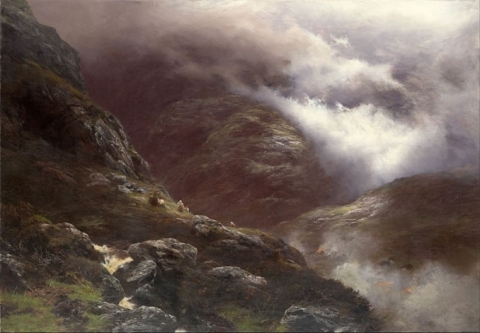Infamy of the Massacre of Glencoe 13th February 1692

The Massacre of Glencoe (Scottish Gaelic: Mort Ghlinne Comhann) took place 330 years ago but the memory of the horror and infamy of the events that took place early in the morning of 13 February 1692 remain poignant. One of the most beautiful places in Scotland Glen Coe (Scottish Gaelic: Gleann Comhann) takes its name from the River Coe that winds and tumbles its way through the glen. It is hard for those who visit this area of great beauty today to think that it was the site of such a treacherous act of murder and brutality against the Clan MacDonald of Glencoe.
The massacre at Glencoe dates back to the removal of King James VII of Scotland and II of England from the throne of both countries and his replacement by King William (Prince of Orange). Those Scots who continued to support James following his exile to France were seen as a threat. The massacre of the MacDonalds was an act of intimidation by the new King of England to the other Scottish Highland Clans who remained loyal to the old king.
Glencoe was home to the MacDonald's. They, along with other Highland Clans had supported the cause of King James in the Scottish Jacobite Rising of 1689-92 which was defeated. John Dalrymple, Master of Stair, had planned the murders. The orders to kill the MacDonalds of Glencoe had been signed by King William with his directive to "extirpate" (eradicate of destroy completely) the MacDonalds of Glencoe. The excuse used for the murders was the delay in the MacDonalds signing a pledge allegiance to King William before New Year’s Day.
In fact, having no other choice, Alasdair MacIain, the Chief of Glencoe, came to Fort Willliam on 31 December 1691 to take the oath. However, he was informed that he would need to go 70 miles to the sheriff at Inveraray to do this. Alasdair MacIain was therefore not able to take the oath until 6 January 1692. Nevertheless, he was given assurances that his allegiance would be accepted and that he along with his people, the McDonalds of Glencoe, would not pay any penalty. This was a lie.
Welcoming any opportunity to make an example of the Highland Clans, John Dalrymple, Master of Stair, who was the Secretary of State, put in place his murderous plan. On 2 February 1692 about 120 troops arrived at Glencoe under the command of Captain Robert Campbell of Glenlyon. During the next 10 days and nights the troops received the hospitality of the MacDonald's and were given food, drink and lodgings. Then at around 5 am on the morning of 13 February 1692 the murders began. Alasdair MacIain of Glencoe was shot dead. Houses were set alight. The troops killed their captives in a brutal and savage manner. The people of Glencoe who could, fled into the mountains. Thirty eight men, women and children were massacred. Many more who attempted to escape across the mountains died of exposure in the cold winter weather.
King William tried to extricate himself from the sinister events that had happened on that dreadful day. Feebly claiming that he had only signed the order because it was buried in a mass of other State papers and he hadn't read it! From that day on, the MacDonalds and other clans harboured a grudge towards a King who was seen as belonging to England and not Scotland. It was a resentment that would continue until the Jacobite risings of the 18th century led to a full scale rebellion against the Crown. It is a resentment that continues to this day. Wreaths are laid annually in memory of the victims at the Glencoe Massacre Memorial on February 13th.
It has been confirmed that a service will take place in St. Mary’s Episcopal Church, Glencoe, at 11 am on Sunday 13th February 2022. After the Church Service people make their way up the village to the Bridge of Coe, then proceed to the Massacre Cross - Upper Carnoch. Where a short service and the laying of wreaths will take place with the Piper organised by the Glencoe Heritage Trust piping throughout.
Painting - Peter Graham (1836 - 18 October 1921 ) - After the Massacre of Glencoe:





